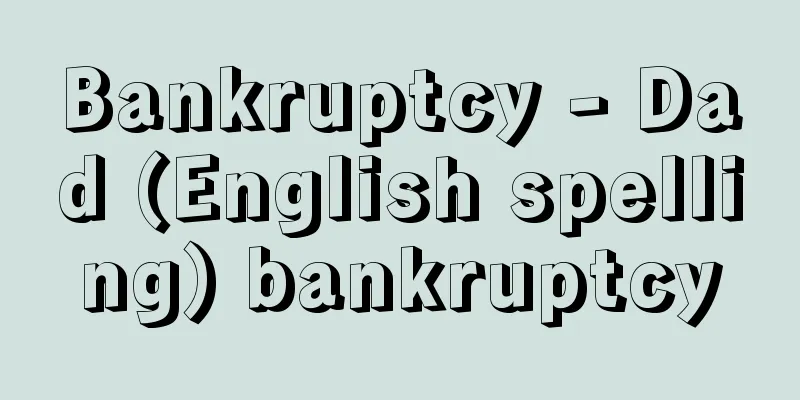Bankruptcy - Dad (English spelling) bankruptcy

|
When a company hits a deadlock in management and collapses. The term bankruptcy has a technical feel to it, but it is not itself a legal term, nor an economic or management term; it is merely a general term to describe the situation when a company hits a deadlock in management and collapses. There are various causes of bankruptcy, but one way of looking at it is to view it as being due to insufficient or missing management resources. For example, a company goes bankrupt when it is unable to carry out the intended business activities due to a lack of necessary personnel. This is known as labor bankruptcy. However, when it comes to bankruptcy, it can be said that all of them are due to financial failure, that is, a lack of funds. Therefore, special expressions such as financial bankruptcy are not commonly used. Generally speaking, bankruptcy refers to a company falling into one of the following states. The first is when a company issues a dishonored check and bank transactions are suspended. The first dishonored check does not suspend bank transactions, but the second does. In other words, suspension of bank transactions is a sign of a serious lack of funds. The second is when a company applies for application of the Corporate Reorganization Law. The Corporate Reorganization Law is a law aimed at reorganizing a joint-stock company that is in a difficult situation due to financial difficulties, but has the potential to be rebuilt, by allowing the company's business to continue while adjusting the interests of creditors, shareholders, etc. The company (or sometimes a major creditor or major shareholder) applies to the court to start reorganization procedures, and once the decision is made, a trustee is appointed, a reorganization plan is drawn up, and reconstruction begins with the court's approval. The third is when a company applies for application of the Civil Rehabilitation Law. The Civil Rehabilitation Law is a restructuring bankruptcy procedure aimed at the early rehabilitation of financially distressed debtors (corporations and individuals) by appropriately adjusting the civil rights between the debtor and creditors through the establishment of a rehabilitation plan approved by the court and with the consent of the majority of the creditors. The fourth is special liquidation under Article 510 of the Companies Act. This is a liquidation of a company under the order and supervision of the court upon the petition of the company (and sometimes creditors, shareholders, or auditors) when the company is in danger of becoming insolvent or becoming insolvent. The fifth is a state of entering into a non-legal internal reorganization. Internal reorganization refers to a company voluntarily trying to recover from a loss by, for example, reducing its capital. The last is when a bankruptcy declaration is made by the court. The modern approach to bankruptcy is to guide the company towards reconstruction whenever possible, as companies have developed and become more socially relevant, with a greater number of stakeholders. [Mitsuo Morimoto] "An Introduction to Modern Bankruptcy Law, by Ando Ichiro (2001, Sanseido)" ▽ "Challenges and the Future of the New Bankruptcy Legislation, by Takagi Shinjiro (2002, Shojihomu)" ▽ "Corporate Bankruptcy and Reconstruction, by Ota Saburo and Okazaki Ichiro (2002, Shojihomu)" ▽ "An Introduction to New Modern Bankruptcy Law, edited by Taniguchi Yasuhei, Yamamoto Katsumi, and Nakanishi Tadashi (2002, Horitsu Bunkasha)" [Reference] | | | | | |Source: Shogakukan Encyclopedia Nipponica About Encyclopedia Nipponica Information | Legend |
|
企業が経営に行き詰まり、つぶれること。倒産という用語は、専門語のような語感をもっているが、それ自体は法律用語でも経済・経営用語でもなく、企業が経営に行き詰まってつぶれるに至った状況を総称する一般用語にすぎない。倒産にはさまざまな原因があるが、一つの見方は、不足もしくは欠落した経営資源によって倒産をとらえるものである。たとえば、必要な人員がそろわなかったため、所期の経営活動が展開できず、そのために倒産に至ることを労務倒産というようなケースである。しかし、倒産といえば、まずそのすべてが財務的破綻(はたん)すなわち資金の不足によるものといってよい。したがって、財務倒産というような特別な表現は普通用いられない。 一般に倒産とよばれているのは、次のうちのいずれかの状態に企業が陥ったことをいう。第一は、不渡手形を出して銀行取引が停止された状態である。1回目の不渡りでは銀行取引は停止にならず、2回目で停止となる。つまり、銀行取引停止は、重大な資金不足の徴候である。第二は、会社更生法の適用申請である。会社更生法は、経営が行き詰まって窮地にあるが再建の見込みのある株式会社について、債権者や株主などの利害を調整しながら会社の事業は継続させ、その更生を図ることを目的にした法律である。会社(ときには大口債権者または大株主)が裁判所に更生手続開始を申請し、決定が出ると、管財人が選任され、更生計画をたて、裁判所の認可を受けて再建に乗り出すことになる。第三は、民事再生法の適用申請である。民事再生法は、経済的に窮境にある債務者(法人および個人)について、その債権者の多数の同意を得、かつ、裁判所の認可を受けた再生計画を定めることなどにより、債務者と債権者との間の民事上の権利関係を適切に調整し、債務者が早期に再生を図ることを目的とした再建型倒産処理手続である。第四は、会社法510条以下による特別清算である。それは会社が支払不能または債務超過に陥る危険があるときに、会社(ときには債権者、株主、監査役)の申立てにより、裁判所の命令と監督のもとに行われる会社の清算である。第五は、法律によらない内整理(うちせいり)に入る状態である。内整理とは、企業がたとえば減資等により自主的に欠損状況の回復を図ることをいう。最後に、裁判所により破産宣告がなされた場合である。 倒産に対する現代の考え方は、可能な限り再建の方向へ誘導するというものであり、それは、企業が発展して社会性が高まり、利害関係者が多数化したからである。 [森本三男] 『安藤一郎著『現代倒産法入門』(2001・三省堂)』▽『高木新二郎著『新倒産法制の課題と将来』(2002・商事法務)』▽『太田三郎・岡崎一郎著『企業倒産と再生』(2002・商事法務)』▽『谷口安平・山本克己・中西正編『新現代倒産法入門』(2002・法律文化社)』 [参照項目] | | | | | |出典 小学館 日本大百科全書(ニッポニカ)日本大百科全書(ニッポニカ)について 情報 | 凡例 |
<<: Sugar acid - saccharic acid
>>: Current account - touzayoki
Recommend
Asadaya
A group of Japanese inns, traditional Japanese res...
Kanzakura - Kanzakura
A deciduous tall tree of the Rosaceae family (APG...
Pellaea rotundifolia (English spelling)
…[Shigeyuki Mitsuda]. … *Some of the terminology ...
Magistrate of construction - Sakujibugyo
An office system in the Edo Shogunate. Establishe...
Academic achievement survey - gakuryokuchosa
...However, even though various techniques have b...
Marimba - Marimba (English spelling)
A general term for African xylophones, and a type...
Energy band
This refers to the quantum mechanical energy leve...
Anaspida
… [Systematics and Classification] The ancestral ...
Kayama Festival - Kayama Festival
...Mosquito poles, mosquito nets, and mosquito sl...
Kokka
An art magazine. It was first published in Octobe...
Axe - Axe
〘Noun〙① A large axe used for cutting trees. In the...
Phacops
…They may also form geographically distinct fauna...
Chrysopidae - Chrysopidae
…This word was introduced to Japan with the intro...
Master of Sake - Kushinokami
A chief in charge of alcohol matters. "this S...
Bhakra Dam
A multipurpose dam built by damming the Sutlej Riv...




![Ago [town] - Ago](/upload/images/67cad2687dcb5.webp)




